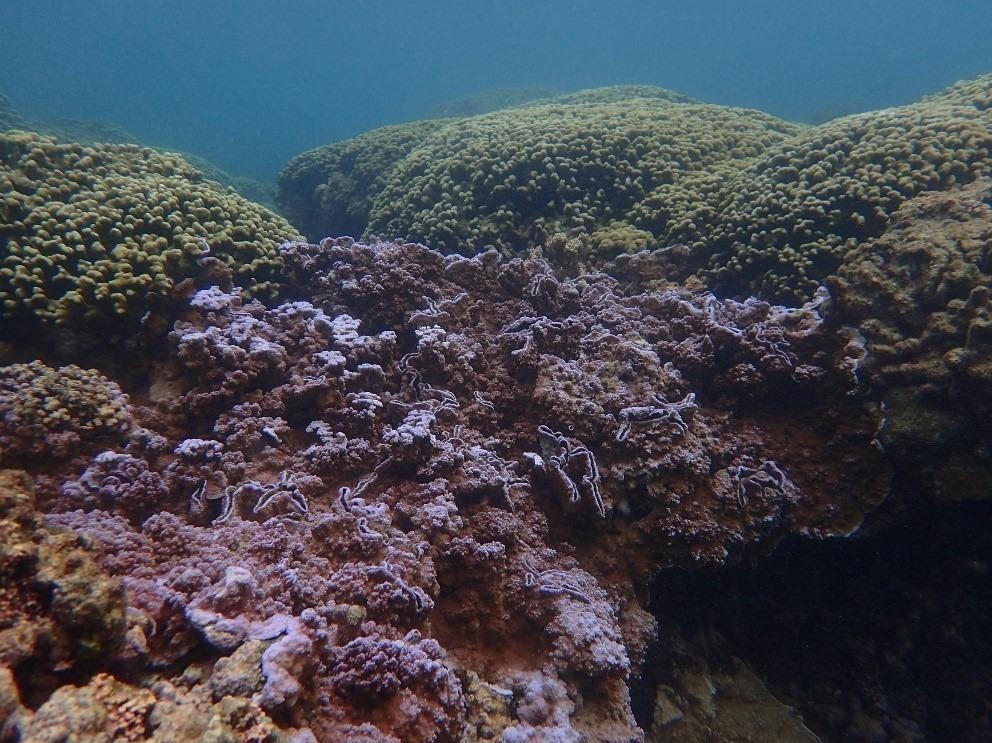Jun 10 2021
Researchers at Smithsonian Conservation Biology Institute are one step closer to understanding why certain corals have the ability to endure climate change better than others and the secret may lie in a particular protein that creates a natural sunscreen.
 A recent study by Smithsonian Conservation Biology Institute scientists found that the blue-hued chromoproteins in Hawaiian blue rice coral (foreground) may make it more resilient to UV rays and climate change than corals that are brown in color (background). Image Credit: Mike Henley/Smithsonian.
A recent study by Smithsonian Conservation Biology Institute scientists found that the blue-hued chromoproteins in Hawaiian blue rice coral (foreground) may make it more resilient to UV rays and climate change than corals that are brown in color (background). Image Credit: Mike Henley/Smithsonian.
As their name implies, Hawaiian blue rice corals have a deep blue pigment produced by chromoprotein and removes dangerous ultraviolet (UV) radiation from the sun. While UV damage may have a lasting impact on reproduction in several coral species — such as brown rice coral — it might not have the same impact on blue rice coral.
The study results were reported in the article titled, “Reproductive plasticity of Hawaiian Montipora corals following thermal stress” in the Scientific Reports journal on June 7th, 2021.
Having witnessed firsthand the devastating effects bleaching had on brown rice coral in 2014 and 2015, it is encouraging to see blue rice coral either recovered quickly after bleaching or was not affected by elevated ocean temperatures at all. By studying blue rice corals’ reproductive successes, we can better understand how other corals weather climate change and ocean warming.
Mike Henley, Study Lead Author and Scientist, Smithsonian Conservation Biology Institute
The color of coral is derived from tiny protozoa known as zooxanthellae. These algae survive within the coral tissue and act as the primary food source for reef-building, shallow corals, such as blue rice coral and brown rice coral. They share a symbiotic relationship; the zooxanthellae. The coral protects the zooxanthellae, and in return, the zooxanthellae provide the coral with food.
Such algae also create a sunscreen for the coral. Corals are essentially animals that are incapable of photosynthesis, whereas zooxanthellae are. The waste products of their photosynthesis are sugars that sustain the coral. But when ocean temperatures become warmer, corals get stressed and the symbiosis collapses. Warm temperatures expedite the metabolism of zooxanthellae, causing them to release a poisonous compound.
As a result, the coral releases the algae and their sunscreen, leaving them exposed to harmful UV damage. These species receive most of their coloring from the zooxanthellae and the expulsion causes the coral to “bleach,” or appear lighter in appearance — varying from dark hue to a paler hue.
Bleaching also impacts the ability of some corals to reproduce effectively. Upon ejecting their zooxanthellae and, thus, losing their UV protection, corals' DNA is at higher risk of being damaged.
In particular, variations in their sperm cells’ mitochondria can impact their motility (potential to swim) over the long term. If the corals are unable to reproduce successfully, they cannot create new offspring but this may lead to genetic changes that make them more impervious to warming temperatures and help them acclimatize to changing oceans.
After the completion of 2014 and 2015 bleaching events in Hawaii, the researchers noted that the blue rice coral had unusual reproductive vigor at 90% motility. On the other hand, its brown-pigmented counterparts’ motility was just half this amount.
This indicates that even if brown corals endure the bleaching events and appear to be visually healthy, the damage induced by UV exposure and bleaching could have long-term effects on their potential to reproduce successfully. The main factor in the blue rice coral’s potential to successfully reproduce may lie in its sunscreen pigment, which the coral may preserve even if it bleaches.
By gaining a better understanding of the role played by UV-protective pigments in reducing the unfavorable impacts of warming oceans and climate change, researchers can learn why few species are better equipped to live and thrive in varying surroundings than others.
Journal Reference:
Henley, E. M., et al. (2021) Reproductive plasticity of Hawaiian Montipora corals following thermal stress. Scientific Reports. doi.org/10.1038/s41598-021-91030-8.